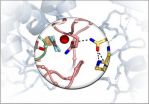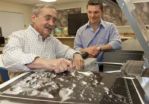(Press-News.org) Measuring three biomarkers in a single blood sample may improve physicians' ability to identify patients at high risk of developing chronic kidney disease (CKD), according to a study appearing in an upcoming issue of the Journal of the American Society of Nephrology.
"Our results identify biomarkers that can improve CKD risk prediction," comments Caroline S. Fox, MD, MPH of the National Heart, Lung, and Blood Institute's Framingham Heart Study, Framingham, Mass.
The study included more than 2,300 participants in the Framingham Offspring Study, a long-term follow-up study of heart disease risk factors and outcomes. All participants had normal kidney function when they provided blood samples in 1995-98. An average of 9.5 years later, nine percent of patients had developed CKD. Another eight percent had high levels of protein in the urine (macroalbuminuria) at follow-up—a key sign of deteriorating kidney function
Stored blood samples from 1995-98 were tested to see if any of six different biomarkers could predict which patients were most likely to develop CKD. A combination of three biomarkers significantly improved the ability to identify patients at high risk of CKD, including homocysteine, a marker of atherosclerosis risk, and aldosterone, a hormone that affects salt handling by the kidneys. The same two biomarkers also predicted the risk of macroalbuminuria, as did B-type natriuretic peptide (BNP)—an indicator of heart damage in patients with heart failure.
Adding the biomarker results to standard risk factors like high blood pressure and diabetes would lead to an additional seven percent of patients being classified at high risk of CKD.
"Chronic kidney disease affects 13 percent of the adult population in the United States and is an important risk factor for cardiovascular disease," Fox explains. "It is difficult to identify early abnormalities using serum creatinine, the most commonly used measure to assess kidney function."
With further testing, these biomarkers identified could improve estimates of CKD risk. In addition, the nature of the three biomarkers may provide important clues into how CKD develops. Further studies are needed to see if treatments that reduce homocysteine levels or target the processes involving aldosterone and BNP can reduce the long-term risk of CKD.
The study was limited to participants of European ancestry; more research is needed to see if the results are generalizable to multiethnic populations.
INFORMATION:
Disclosures: This study was supported by the National Heart, Lung, and Blood Institute's Framingham Heart Study (N01-HC-25195), 2-K24-HL04334, R01-HL-077477, R01-DK-080739, 1R01 AG028321. Study coauthors included Vasan Ramachandran, MD (also of the Framingham Study).
The article, "A Multi-Marker Approach to Predict Incident CKD and Microalbuminuria," will appear online at http://jasn.asnjournals.org/ on October 21, 2010, doi 10.1681/ASN.2010010085.
The American Society of Nephrology (ASN) does not offer medical advice. All content in ASN publications is for informational purposes only, and is not intended to cover all possible uses, directions, precautions, drug interactions, or adverse effects. This content should not be used during a medical emergency or for the diagnosis or treatment of any medical condition. Please consult your doctor or other qualified health care provider if you have any questions about a medical condition, or before taking any drug, changing your diet or commencing or discontinuing any course of treatment. Do not ignore or delay obtaining professional medical advice because of information accessed through ASN. Call 911 or your doctor for all medical emergencies.
Founded in 1966, ASN is the world's largest professional society devoted to the study of kidney disease. Comprised of 11,000 physicians and scientists, ASN continues to promote expert patient care, to advance medical research, and to educate the renal community. ASN also informs policymakers about issues of importance to kidney doctors and their patients. ASN funds research, and through its world-renowned meetings and first-class publications, disseminates information and educational tools that empower physicians.
Simple blood test helps predict chronic kidney disease
3 biomarkers provide clues about how kidney disease develops
2010-10-22
ELSE PRESS RELEASES FROM THIS DATE:
LRO's LAMP ultraviolet spectrograph observes LCROSS blast, detects surprising gases in impact plume
2010-10-22
NASA's Lunar Reconnaissance Orbiter (LRO) and its sophisticated suite of instruments have determined that hydrogen, mercury and other volatile substances are present in permanently shaded soils on the Moon, according to a paper published today in Science.
The Lunar Crater Remote Observation and Sensing Satellite (LCROSS), which launched with LRO, was intentionally crashed onto the Moon's surface Oct. 9, 2009, while LRO instruments watched. About 90 seconds after LCROSS hit the Moon, LRO flew past the debris plume raised by the impact, while the Lyman Alpha Mapping Project ...
Iowa State, Ames Lab chemists discover proton mechanism used by flu virus to infect cells
2010-10-22
AMES, Iowa – The flu virus uses a shuttle mechanism to relay protons through a channel in a process necessary for the virus to infect a host cell, according to a research project led by Mei Hong of Iowa State University and the Ames Laboratory.
The findings are published in the Oct. 22 issue of the journal Science.
Hong, an Iowa State professor of chemistry and an associate of the U.S. Department of Energy's Ames Laboratory, said her research team used solid-state nuclear magnetic resonance (NMR) spectroscopy to determine the structure and workings of the proton channel ...
Putting a bull's-eye on the flu: Detailing influenza's structure for drug targeting
2010-10-22
Beating the flu is already tough, but it has become even harder in recent years – the influenza A virus has mutated so that two antiviral drugs don't slow it down anymore.
Reporting their findings in the journal Science, researchers from Florida State and Brigham Young move closer to understanding why not, and how future treatments can defeat the nasty bug no matter how it changes.
The two drugs, amantadine and rimantadine, are no longer recommended by the CDC for use against flu.
They used to work by blocking a hole in the influenza A virus called the "M2 channel," ...
Study details molecular structure of major cell signaling pathway
2010-10-22
(Embargoed) Scientists at the University of North Carolina at Chapel Hill School of Medicine have reported the exact molecular structure and mechanisms of a major cell signaling pathway that serves a broad range of functions in humans.
Up to half of drugs approved by the US Food and Drug Administration directly or indirectly target G protein-coupled receptors. These receptors, which are proteins that live in the outer membranes of cells, take molecular signals from outside the cell and convert them into responses within – and those responses help control behaviors as ...
Risk gene for severe heart disease discovered
2010-10-22
Research led by Klaus Stark and Christian Hengstenberg of the University of Regensburg identified a common variant of the cardiovascular heat shock protein gene, HSPB7, which was found to increase risk for dilated cardiomyopathy by almost 50%. Their paper appears on October 28 in the open-access journal PLoS Genetics.
Per year, about 6 in 100,000 individuals develop dilated cardiomyopathy (DCM), with a higher prevalence in men. This disease is characterized by an enlarged, weakened heart, subsequently affecting the pumping capacity and often leading to chronic heart failure. ...
Mathematical model helps marathoners pace themselves to a strong finish
2010-10-22
CAMBRIDGE, Mass. -- Most marathon runners know they need to consume carbohydrates before and during a race, but many don't have a good fueling strategy. Now, one dedicated marathoner -- an MD/PhD student in the Harvard-MIT Division of Health Sciences and Technology -- has taken a more rigorous approach to calculating just how much carbohydrate a runner needs to fuel him or herself through 26.2 miles, and what pace that runner can reasonably expect to sustain.
The result is a new model, described in the Oct. 21 issue of the journal PLoS Computational Biology, which allows ...
NASA-engineered collision spills new Moon secrets
2010-10-22
VIDEO:
Peter Schultz and graduate student Brendan Hermalyn analyzed data from bits of the Moon’s surface kicked up by a NASA-engineered collision. They found unexpected complexity -- and traces of silver....
Click here for more information.
PROVIDENCE, R.I. [Brown University] — Scientists led by Brown University are offering the first detailed explanation of the crater formed when a NASA rocket slammed into the Moon last fall and information about the composition of the ...
Stanford study links cancer to loss of protein that hooks skin cells together
2010-10-22
STANFORD, Calif. — In a study to be published online Oct. 21 in PLoS Genetics, researchers at the Stanford University School of Medicine have implicated the lack of a protein important in hooking our skin cells together in the most common variety of skin cancer. Depletion of this protein, called Perp, could be an early indicator of skin cancer development, and could be useful for staging and establishing prognoses.
These findings' significance may extend beyond skin cancer, as Perp is found in the linings of many of our internal organs, where it plays the same role it ...
Protein injection shows promise in lowering elevated triglycerides
2010-10-22
Injecting a protein that helps break down triglycerides may someday help treat an inherited form of high triglycerides, according to a new study in Arteriosclerosis, Thrombosis, and Vascular Biology, an American Heart Association journal.
Triglyceride is a type of fat in the blood. Elevated levels in the blood — hypertriglyceridemia — have been linked to coronary artery disease.
In the study, researchers tested a new compound in mice genetically altered to be deficient in a protein called apolipoprotein (apo)A-V, which causes them to have high blood levels of triglycerides. ...
Treating metabolic syndrome, undergoing carotid angioplasty
2010-10-22
Treating metabolic syndrome and undergoing carotid angioplasty may prevent recurrent stroke or transient ischemic attack (TIA), according to revised American Heart Association/American Stroke Association guidelines.
Last updated in 2006, the evidence-based guidelines for doctors will be published in Stroke: Journal of the American Heart Association.
"Patients who've had a stroke or TIA are at highest risk for having another event," said Karen Furie, M.D., M.P.H., writing committee chair and stroke neurologist. "Since the last update, we've had results from several studies ...
LAST 30 PRESS RELEASES:
Post-stroke injection protects the brain in preclinical study
Cardiovascular risk score predicts multiple eye diseases
Health: estimated one in ten British adults used or interested in GLP-1 medications for weight loss
Exercise to treat depression yields similar results to therapy
Whooping cough vaccination for pregnant women strengthens babies’ immune system
Dramatic decline in new cases of orphanhood in Uganda driven by HIV treatment and prevention programs
Stopping weight loss drugs linked to weight regain and reversal of heart health markers
Higher intake of food preservatives linked to increased cancer risk
Mass General Brigham–developed cholera vaccine completes phase 1 trial
First experimental validation of a “150-year-old chemical common sense” direct visualization of the molecular structural changes in the ultrafast anthracene [4+4] photocycloaddition reaction
Lack of support for people on weight loss drugs leaves them vulnerable to nutritional deficiencies, say experts
Dogs’ dinners can have greater climate impact than owners’
Are you ready to swap salmon for sprats and sardines?
1.6 million UK adults used weight loss drugs in past year
American College of Cardiology comments on new dietary guidelines for Americans
American Society of Gene & Cell Therapy and Orphan Therapeutics Accelerator partner to advance and commercialize promising rare disease treatments
One in 14 patients having day case surgery have new or worse chronic pain 3 months after their operation
New study highlights link between eviction rates and gun violence
Heatwaves heat up soil but not toxin levels in rice, study finds
Digital modeling reveals where construction carbon emissions really come from
Turning farm waste into water filters
New study shows how the spleen helps the immune system accept a transplant
New Mayo Clinic study advances personalized prostate cancer education with an EHR-integrated AI agent
Researchers identify novel therapeutic target to improve recovery after nerve injury
Microbes in breast milk help populate infant gut microbiomes
Reprogramming immunity to rewrite the story of Type 1 diabetes
New tool narrows the search for ideal material structures
Artificial saliva containing sugarcane protein helps protect the teeth of patients with head and neck cancer
Understanding the role of linear ubiquitination in T-tubule biogenesis
Researchers identify urban atmosphere as primary reservoir of microplastics
[Press-News.org] Simple blood test helps predict chronic kidney disease3 biomarkers provide clues about how kidney disease develops




